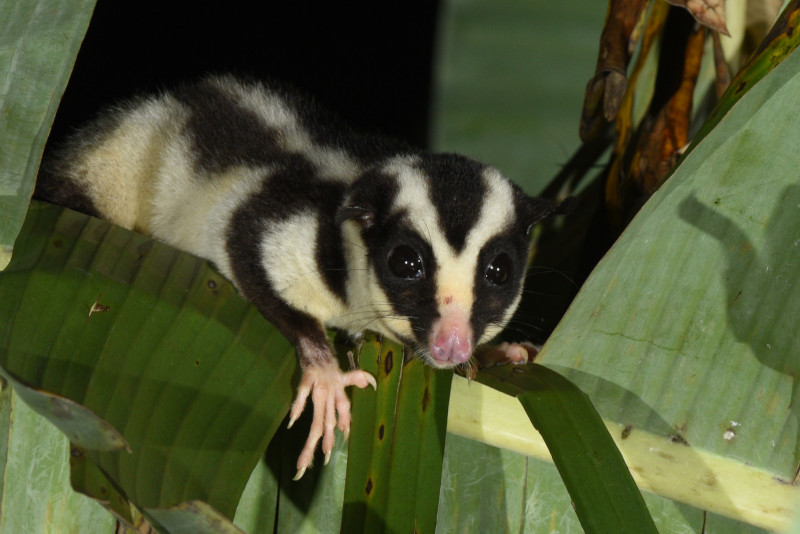
Striped Possum Facts
- This highly distinctive creation of Nature and evolution is most frequently referred to by the obviously appropriate common name of the Striped Possum. Yet, it also has one other general title. That’s the extremely similar common striped possum.
- Inside of scientific circles, however, it’s possibly better known by its technical designation. Like many such epithets, though, that’s a difficult one for the layperson to pronounce. That’s because the mammal holds the formal tag of Dactylopsila trivirgata.
- The small wonder of evolution received that moniker due to the efforts of John Edward Gray. This respected British zoologist made the first acknowledgement of the animal as a separate and distinct species. He managed that noteworthy feat in 1858.
- Overall, the amazing Striped Possum appears to be maintaining a stable and sufficient population base. The IUCN therefore currently lists it as Least Concern. In individual portions of its range, however, its situation isn’t quite as stable as in others.
- In these regions, and indeed in all parts of its range to some extent, it faces multiple threats to its existence. In this, though, it but mirrors the situation all species on earth now face. We’re all dealing with the dangers of habitat loss and climate change.
Related Articles
Striped Possum Physical Description
The remarkable Striped Possum typically captures the immediate attention of those fortunate enough to encounter it. This beatiful animal does so for reasons that vary with individuals, of course. Sheer, physical size, however, rarely lists among those factors.
In terms of physical attributes, such as the aforementioned size, the species does display a certain degree of the physiological characteristic of sexual dimorphism. In its case, though, these natural differences remain relatively minor, with one very notable exception.
That’s due to the fact that, despite its small stature, this species evolved as a marsupial. Like all members of this infraclass, the females therefore possess a pouch for the young that the males lack. Otherwise, the physical differences between the sexes is much less obvious.
Overall, an average body length measures approximately 10.35 in (26.3 cm). The somewhat bushy tail, meanwhile, grows even longer, averaging roughly 12.8 (32.5 cm). Males do tend to achieve greater measurements in each of these categories, but only marginally so.
Yet, the wonders of the Striped Possum do not simply end there, however. That adorable tail also serves a useful purpose, as it’s fully prehensile in nature. The mammal also has a highly elongated fourth finger on its front paws, much like the equally remarkable aye-aye.
It also presents an intriguing pattern of coloring. This consists of an alternating pattern of stripes of black and off-white, running along its body. These extend from the tips of its nose to the tip of the tail. The small nose itself contrasts this with a bright pink shade.
- Kingdom: Animalia
- Phylum: Chordata
- Class: Mammalia
- Order: Diprotodontia
- Family: Petauridae
- Genus: Dactylopsila
- Species: D. trivirgata
Striped Possum Distribution, Habitat, and Ecology
Sadly, the amazing Striped Possum appears to have evolved as native to only a moderate expanse of the surface of the earth. The majority of it also qualifies as relatively remote. The specific section it developed as native to likely won’t surprise many people, though.
That’s due to the fact that this small marvel of Nature evolved as primarily indigenous to the island of New Guinea. Smaller concentrations, though, also live on in Queensland, and on nearby islands. This distribution even includes certain parts on Indonesia.
Fortunately, the beautiful creature also displays a high degree of flexibility in its choice of habitat. It principally makes its home in regions comprised on areas of dense rainforests. Yet, when that’s not available, it seems equally at home in other types of forests.
In each of these various regions, however, one requirement remains the same. That’s the presence of copious quantities of thick vegetation. In most instances, this consists of the upper canopy. Here, its prehensile tail serves it well in a variety of useful roles.
The intriguing Striped Possum isn’t just arboreal in nature, it’s also primarily nocturnal, as well. It thus conducts most of its many activities in the relative cool of the night, including feeding. Technically, the impressive species classifies as omnivorous in nature.
It consumes a wide array of small invertebrates, such as caterpillars and beetles found in its habitat. Yet, it mainly consumes plant matter. This includes a number of locally available fruits. It also feeds on the leaves of some plants, and possibly the nectar of some flowers.
Species Sharing Its Range
Check out our other articles on 3 Magical Marvels of Yellowstone, Southern Elephant Seal, Lake Atitlan, Southern Stingray, Axolotl, Snake’s Head Fritillary, Indian Vulture, Philippine Cobra
